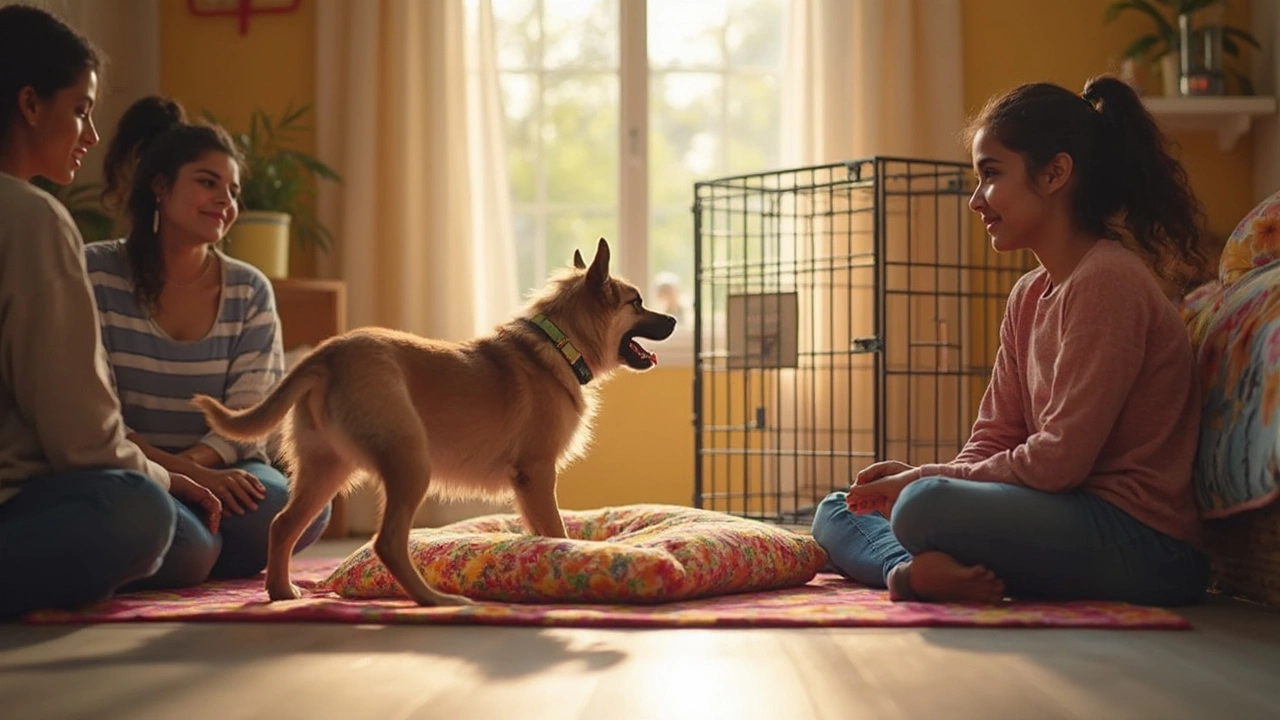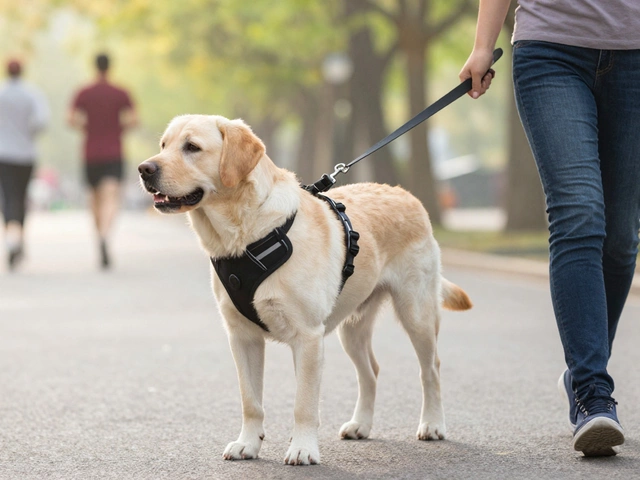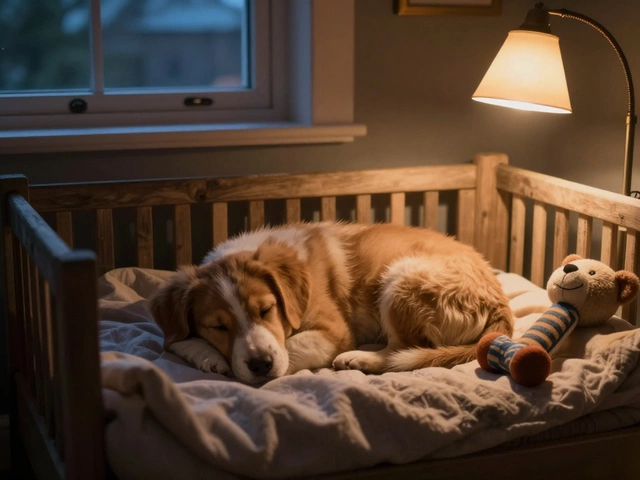
Ever wondered if there’s an age when crate sleeping just isn’t right for your dog anymore? You’re not alone. The answer isn’t just about numbers—it’s about your dog’s behavior, confidence, and habits. Most dogs can safely move from a crate to a regular dog bed somewhere between 18 months to 2 years, but some pups may be ready sooner, while others need a bit more time. My own dog, Luna, started claiming her dog bed at two, but she still sneaks back to her crate sometimes for a nap.
Before ditching the crate, you want to make sure your dog is mature enough not to chew on wires, shoes, or even start redecorating your living room while you sleep. Crates help a lot with house training and keeping young dogs out of trouble, but they’re not a forever thing for most pets. When the crate stops being a tool and starts feeling like a cage, that’s when it’s time to think about the switch.
- Why People Crate Dogs in the First Place
- Signs Your Dog is Ready to Leave the Crate
- Ideal Ages for Moving From Crate to Dog Bed
- How to Make the Switch Smooth for Your Dog
Why People Crate Dogs in the First Place
Crate training isn’t just a trend—there are pretty good reasons why millions of dog owners use crates. First off, puppies need clear structure. A crate is like their own bedroom where they feel safe, especially during those first nights home. It’s familiar, so travel or vet visits stress them out less when they have their crate around.
One of the biggest wins? Dog crate training makes housebreaking much quicker. Most dogs don’t want to pee or poop where they sleep, so a crate helps teach them bladder control fast. Plus, if you’ve ever brought home a curious chewer, you know a crate saves you from shredded shoes or destroyed remotes when you leave the room.
- Speeds up potty training
- Keeps puppies out of trouble
- Offers a safe haven if your dog feels anxious
- Makes travel and vet visits easier
- Helps dogs recover after surgery or injury
Not all dogs are fans right away, but a crate has real benefits when used right. According to the American Veterinary Medical Association, crate-trained dogs are less likely to develop anxiety-related behavior problems down the line.
| Reason | Benefit |
|---|---|
| House training | Prevents accidents, teaches good habits |
| Safety | Keeps dogs away from household hazards |
| Travel | Makes moving or vet trips less stressful |
| Recovery | Restricts movement after surgeries or injuries |
If you set up the crate comfy and never use it as punishment, most dogs actually see it as their chill-out spot. Luna (my dog) even drags her favorite toy inside when she wants to zone out. So, crates are all about safety, comfort, and making life a whole lot smoother for both you and your dog.
Signs Your Dog is Ready to Leave the Crate
Wondering if your dog is done with crate life? Most dogs show you in pretty clear ways when they’re ready. The main thing to look for is whether your dog can hang out alone in the house without getting into trouble. Think about when you leave for an hour—does your dog greet you calmly or have they torn up a pillow? If your answer is calm, you’re probably close to being done with the crate.
Here are the main signs to check for before moving your dog to a regular dog crate:
- No accidents: Your dog shouldn’t be having potty accidents in your absence, even if you’re gone a few hours.
- Can handle freedom: Items in your house (like shoes, chargers, or the trashcan) are safe and untouched while you’re gone.
- Stays relaxed: Your dog doesn’t bark, whine, or scratch at doors when left alone.
- Crate is just a chill-out spot: They choose to nap in the crate when they want, not because they’re locked in.
- Mature, steady behavior: You notice fewer puppy-like impulses and more calm, predictable reactions.
Every dog is different, but stats from surveys in 2023 showed that about 82% of dog owners waited until their dogs reached at least 18 months old before giving full house freedom at night. Check out this quick breakdown:
| Dog Age | Ready for Bed Freedom (%) |
|---|---|
| 12 months | 27% |
| 18 months | 55% |
| 24 months+ | 82% |
Sometimes, hearing it from the pros helps too. As dog trainer Victoria Stilwell puts it:
"When your dog can be reliably trusted while left alone and no longer needs confinement for safety or house training, it's usually time to retire the crate as a bed."
Don’t rush this. If you’re not sure, do a trial run. Let your dog nap outside the crate while you’re home. Watch for any problem behaviors. If things go smoothly, extend to short outings and keep building trust. Only move on when you’re seeing real, consistent success.

Ideal Ages for Moving From Crate to Dog Bed
There’s no magic age when you have to stop using a crate, but most dog owners find the best window is between 18 months and 2.5 years. At this age, many dogs are done teething, less likely to gnaw on random things at night, and their house-training is usually rock solid. Puppies, especially before one year, just aren’t there yet. They can still get into trouble or hurt themselves if left alone outside the crate.
Larger breeds, like Labs and Goldens, sometimes take a little longer to settle down compared to smaller dogs. They might not be fully trustworthy until closer to age three. Smaller breeds or dogs with super chill personalities can sometimes handle the freedom a bit earlier. It really depends on the dog’s maturity and how they behave when you leave them alone.
If your dog has gone at least several months without any big messes, chewed-up furniture, or middle-of-the-night barking, that’s usually a green light. Rule of thumb? Give it a test run during the day before making a full switch at night. That way, if your buddy decides to throw a puppy party in the living room, you’re around to stop it.
Here are a few signs your dog might be ready to ditch the dog crate and try out a big kid bed:
- No recent potty accidents in the house
- Chewing phase is truly over (all shoes are safe!)
- They relax and sleep without getting into mischief when you’re home
- They don’t act anxious or destructive when left alone for short periods
The switch doesn’t have to be all at once. Some dogs love the option of both—Luna did for months. You can leave the crate door open so they can choose. Just watch for signals, and don’t rush it.
How to Make the Switch Smooth for Your Dog
Ready to help your dog move from the crate to a real dog bed? Planning is your best friend. Most dogs feel comfortable with change when it’s done step by step. Don’t just toss the crate out overnight or your dog might freak out and go looking for a safe spot—or chew up your couch out of stress.
Start with these tips to make the process easier:
- Place the new dog bed right next to the crate at first. This lets your dog get used to the bed while still having the crate nearby for comfort.
- Keep a familiar blanket or toy on the new bed. The scent reminds your dog of home, making the transition less scary.
- Allow your dog to choose. Leave the crate door open at night and let them pick between the crate and the new bed. You’ll see which one gets their vote.
- Stick to your dog’s normal bedtime routine during the change. A regular schedule keeps them calm and helps build new habits faster.
- If you see your dog pacing, whining, or acting anxious, don’t force it. Some dogs just need more time to feel safe away from the crate. Go back a step if needed.
Here’s another trick: gradually move the crate farther from your dog’s sleeping area over a few days. This makes the bed feel like the new normal, not just a weird addition. If accidents or nighttime wanderings happen, don’t get discouraged—just add a baby gate or keep your dog’s bed in a dog-proof room at first.
The main thing is patience. Every dog is different. And when your dog finally curls up and zonks out on their new dog bed, you’ll know you made the switch at the right pace. A stress-free change means a happier dog—and way fewer chewed shoes.





